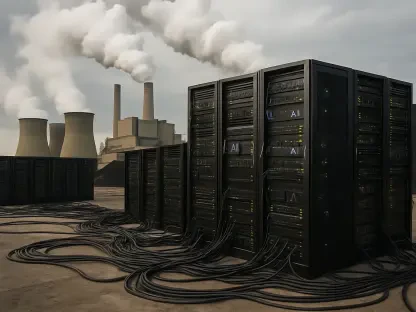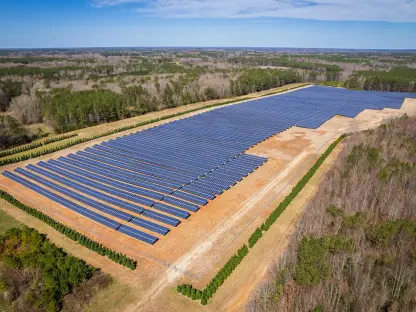The advent of artificial intelligence (AI) is revolutionizing industries across the globe, offering unparalleled opportunities for advancement and innovation. However, this digital evolution also presents significant challenges, particularly for Europe, where infrastructure limitations are looming large. The Netherlands is currently experiencing a substantial bottleneck in its electrical grid, underscoring a broader continental issue that may impede the progress of AI technologies. With more than 11,900 businesses in the Netherlands alone clamoring for electricity connections, the gap between ambition and reality in the digital economy becomes glaringly evident. This situation highlights a critical tension between expanding digital ambitions and the constraints of outdated and insufficient energy systems.
Confluence of Ambitions and Reality
Digital Growth Outpacing Physical Infrastructure
Europe is at a critical juncture as the rise of digital enterprises collides with inadequate energy support systems. Data centers, particularly those supporting AI operations, demand vast amounts of electricity, equivalent to that of tens of thousands of households. As sectors like manufacturing, finance, and healthcare increasingly rely on AI, these demands are likely to magnify. The conundrum presents a formidable challenge: delivering reliable power to feed an insatiable appetite for computation without overburdening the existing power grids. Each step towards digital transformation inadvertently adds pressure on aging infrastructure, revealing stark contrasts between visionary planning and the tangible limitations of present systems.
The Aftermath of the Groningen Gas Field Closure
The energy landscape underwent a dramatic shift following the shutdown of the Groningen gas field in 2023. Driven initially by safety concerns about earthquakes, this closure intensified Europe’s existing energy crisis, spearheading a swift pivot towards electrification. The momentum to reduce reliance on fossil fuels was further catalyzed by the European Union’s broader energy crisis. However, these well-meaning transitions illuminated glaring deficiencies in grid development. Decades of underinvestment left many networks ill-prepared to handle the sudden upsurge in electricity demand, stressing the necessity for comprehensive upgrades. Such developments cast a spotlight on the wider implications for Europe: the need to reconcile historical energy reliance with modern digital requirements.
Energy and Economic Scattershot
Tangible Costs of Grid Congestion
Grid congestion across Europe is resulting in unanticipated economic stresses. Recent years have witnessed significant spikes in congestion management costs, with countries like Germany and Great Britain seeing their expenses triple. Meanwhile, the Netherlands has grappled with even steeper cost surges, highlighting the pervasive challenge of managing overtaxed grids. Businesses, particularly data centers, find themselves in extended queues for connection, underscoring systemic bottlenecks that risk hampering competitiveness. With expected delays ranging up to a decade in parts of Germany and the UK, this lag becomes increasingly perilous for Europe’s stature in a rapidly digitizing global marketplace.
Implications for Competitiveness and Growth
The grid crisis poses real threats to Europe’s economic ascendancy. Energy limitations not only strain operations but also curb the growth potential of burgeoning tech sectors. With data centers facing soaring electricity costs and prolonged timelines for securing power, many enterprises are contemplating relocation, seeking environments where infrastructure aligns more closely with digital demands. Cities like Frankfurt, crucial nodes for Europe’s data traffic, confront looming constraints, with no additional grid capacity planned until the next decade. Such scenarios advocate for a reevaluation of digital strategy, balancing AI deployment with the pragmatism of energy availability.
Strategic Integration and Regulatory Challenges
Unifying Policies for Comprehensive Solutions
The disparity in national energy policies and regulations poses another layer of complexity in addressing this crisis. Varying network codes and legislative approaches hinder the formulation of a unified strategy across Europe. The EU has initiated consultations aiming to streamline grid enhancements, but immediate relief appears distant. These varied regulatory frameworks add to the convoluted landscape, necessitating a more cohesive approach to realize efficient infrastructural solutions. While there is recognition of AI’s potential to optimize these systems, hurdles such as data transparency and proprietary restrictions persist, demanding innovative strategies to reconcile these advanced capacities with regulatory realities.
Prospects for Emerging Technologies and Innovations
Emerging technologies present potential pathways to ease the infrastructure strain. Innovations like edge intelligence and physics-informed machine learning offer promise in reducing the energy intensity of AI, potentially providing temporary reprieve from the need for immediate grid expansion. However, the integration of such advancements requires careful evaluation and strategic guidance. Research institutions and agencies are exploring these avenues, offering data-driven insights that balance immediate needs with long-term viability. However, widespread adoption and implementation of these solutions will require substantial investment and regulatory cooperation, factors that continue to present formidable challenges.
Looking Towards a Collaborative Future
The Dutch grid crisis serves as more than an isolated event; it’s a forewarning of what lies ahead if urgent action is not taken. There is a crucial need for collective efforts across Europe, fostering collaboration between government entities, energy providers, and tech companies to reinforce current systems. Skill shortages compound the problem, with up to 28,000 technicians needed for modern infrastructure upgrades. To maintain competitiveness and foster innovation, targeted investments aimed at strengthening the energy matrix are essential. Enhanced training programs could address technical deficits, equipping a skilled workforce capable of supporting expansive digital frameworks.
Bilaterally, nations like Belgium, Germany, and Ireland are also showing signs of strain, with potential cascading impacts on AI-related business growth. Cooperative EU policies can streamline transitions, offering a more resilient grid capable of sustaining burgeoning digital demands. It’s imperative to establish a forward-thinking regulatory framework and promote continent-wide investment strategies that bolster energy infrastructure to support Europe’s AI aspirations. Failure to embrace these collaborative measures risks relegating the continent to a peripheral role in the global AI race, undermining technological capacity and, consequently, economic vitality.
Pathways Forward for Sustained AI Advancement
Europe finds itself at a pivotal moment as the expansion of digital enterprises is met with the challenge of supporting energy systems that are currently insufficient. Data centers, especially those involved in artificial intelligence operations, consume enormous amounts of electricity—comparable to the energy needs of tens of thousands of households. This becomes more complex as industries such as manufacturing, finance, and healthcare increasingly integrate AI technology, further escalating these energy requirements. Consequently, Europe faces a significant dilemmhow to ensure a stable energy supply to satisfy the growing demand for computation without overwhelming the current power grids.
This situation highlights the tension between futuristic ambitions for digital transformation and the physical constraints of current infrastructural systems. With each technological advancement, there’s added strain on the already aging infrastructure, glaringly spotlighting the disparity between forward-looking strategies and the tangible capabilities of today’s energy networks. As Europe strives to modernize and embrace AI, balancing technological growth with sustainable energy solutions becomes crucial. Failure to address these issues may result in bottlenecks that could stifle progress and affect multiple sectors dependent on reliable digital operations. The path forward demands innovative thinking and a reevaluation of energy policies to adequately support the digital age Europe is fast approaching.









